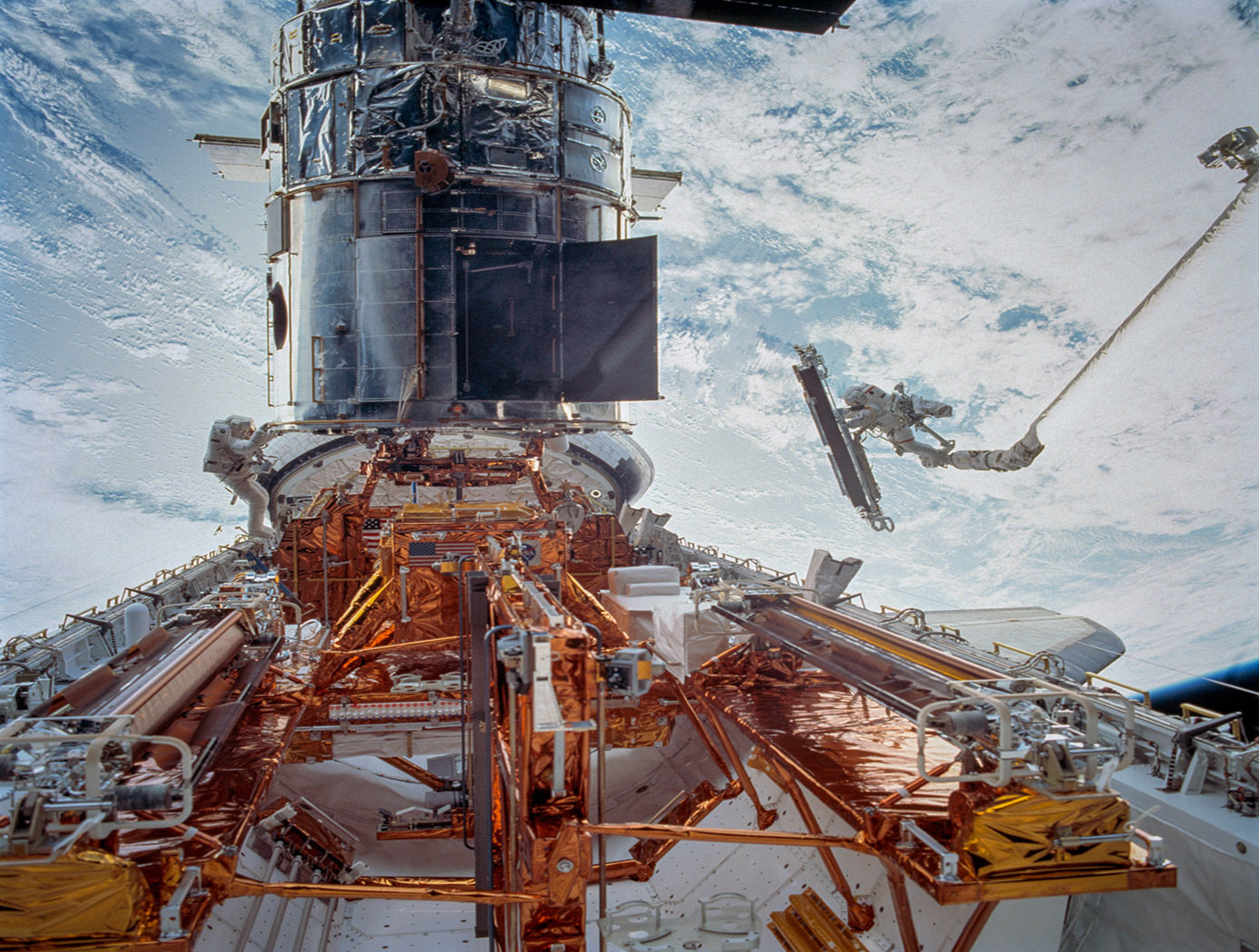Robot-Driven Blind Mate Interface
robotics automation and control
Robot-Driven Blind Mate Interface (GSC-TOPS-247)
A mechanism capable of simultaneously making electrical, fluid, and structural connections in a single motion
Overview
Many robot operations require connecting modules, tools, or other types of hardware to accomplish assembly or servicing tasks. When working in harsh environments, robots must be enabled to make these kinds of connections without human intervention. These robotic operations must be capable of surviving all kinds of harsh environments, from outer space to the deep sea. Additionally, robot operations must be suitable for many different structures and assemblies. As a result, there is a need for a reliable robot-friendly mechanism that allows structural, electrical, and fluid connections to be made. The Robot-Driven Blind Mate Interface is capable of providing connection mechanisms for a variety of couplings and can operate in harsh environments as well.
The Technology
The Robot-Driven Blind Mate Interface is a specialized interface utilizing a robot-driven, blind mate mechanism that allows structural, electrical, and fluid connections to be reliably made in a single motion. The interface is composed of a removable side and a fixed side. The removable side consists of the robot grasp point, a drive bolt, one side of a blind mate fluid, electrical couplings, and one side of the interface alignment features. The fixed side consists of corresponding alignment features and the mechanisms carriage. The carriage houses the corresponding fluid and electrical couplings and over-travel protection for the couplings. The robot system used dictates the specific type of robot grasp point, any required targets, and mechanism status indicators.
The mate and de-mate forces of the interface are balanced throughout the mechanism so it can be actuated with one motion, such as turning a single drive bolt. The point at which the different connectors seat is carefully controlled the spring forces distributed throughout the mechanism. For example, the electrical connectors can make contact before the fluid couplings, if desirable, to accommodate the long length of high voltage and current pins. The springs that compress to provide over-travel protection on the electrical connectors allow for preload to be developed between the removable side and fixed side of the interface to create a sound structural connection while not over-stressing the connectors. Overtravel protection can be applied to fluid couplings as needed depending on the specific coupling used. The interface is versatile and can be tailored to a wide range of fluid and electrical couplings.

Benefits
- Enables use for a variety of coupling types
- Operable in harsh environments
Applications
- Space robotic repairs
- Deep sea robotic repairs
- Hydraulic machinery
Technology Details
robotics automation and control
GSC-TOPS-247
GSC-18182-1
Similar Results

Robonaut 2: Industrial Opportunities
NASA, GM, and Oceaneering approached the development of R2 from a dual use environment for both space and terrestrial application. NASA needed an astronaut assistant able to function in space and GM was looking for a robot that could function in an industrial setting. With this in mind, R2 was made with many capabilities that offer an enormous advantage in industrial environments. For example, the robot has the ability to retool and vary its tasks. Rather than a product moving from station to station on a conveyor with dozens of specialized robots performing unique tasks, R2 can handle several assembly steps at a single station, thereby reducing manufacturing floor space requirements and the need for multiple robots for the same activities. The robot can also be used in scenarios where dangerous chemicals, biological, or even nuclear materials are part of the manufacturing process.
R2 uses stereovision to locate human teammates or tools and a navigation system. The robot was also designed with special torsional springs and position feedback to control fine motor movements in the hands and arms. R2's hands and arms sense weight and pressure and stop when they come in contact with someone or something. These force sensing capabilities make R2 safe to work side-by-side with people on an assembly line, assisting them in ergonomically challenging tasks or working independently.
This NASA Technology is available for your company to license and develop into a commercial product. NASA does not manufacture products for commercial sale.

Robotic System for Infra-structure Reconnaissance
The robotic system is comprised of six main components: the orb that performs the reconnaissance, an orb injector housing that attaches to a piping network, a tether and reel subsystem that attaches to the back of the injector housing, a fluid injection subsystem that attaches toward the front of the injector housing, an external power and data subsystem, and associated control and monitoring software.
Usage of the system begins with an operator attaching the injector housing, with the orb stowed inside, to a flanged gate valve belonging to the piping network of concern. Requisite power, data, and fluid subsystems are attached, and the system is energized for usage. The orb is released via the tether and reel, and a controlled fluid force is imparted on the orb to help guide it along its mission. The tether supplies power and guidance to the orb, and relays real-time data back to the operator.
The orb’s interior features a modular plug-and-play architecture which may comprise COTS instrumentation for reconnaissance or investiga-tion, LIDAR, and inertial measuring and motion sensors. This instru-mentation could be used in combination with other sub-systems such as lighting, and core and sample retrieving mechanisms. These com-ponents are supported by other onboard devices such as a CPU, power source and controller, and data transmission encoders and multiplexers.
The Robotic System for Infrastructure Reconnaissance is at TRL 8 (actual system completed and "flight qualified" through test and demonstration), and is now available for licensing. Please note that NASA does not manufacture products itself for commercial sale.

Robonaut 2: Medical Opportunities
R2's unique systems allow the robot to be used in many telemedicine applications and in many medical scenarios. For example, R2 can assist a surgeon and the surgical team before, during, and after a procedure with multiple tasks. The robot has the vision, dexterity, and the ability to perform tasks tirelessly 24 hours a day, seven days a week. R2 can work safely around humans, so it can be integrated into a dynamic hospital environment.
The R2 technology capabilities in telemedicine are being explored through partnerships with medical institutions. After a quick medical procedure training, a R2 teleoperator was able to guide the robot and perform an ultrasound scan on a medical mannequin. Humans at the controls were able to guide the robot to perform the task correctly and efficiently by using R2's dexterity to apply the appropriate level of force and were able to track their progress using the robot's vision system. The technology was also used to experiment using a syringe and an intubation procedure with a mannequin to demonstrate R2's telemedicine capabilities. R2 is well suited to be used by physicians to conduct medical procedures on humans in remote locations.

Advanced Humanoid Robotic Hand Technologies
The R2 hand and forearm assembly represents the cutting edge of humanoid robotics technologies. The highly modular design provides significant improvements over prior humanoid robotic hands, especially in the areas of strength, speed, sensing, and ability to approximate human grasps.
Hand, Finger, and Wrist Assembly Design: The robotic humanoid lower arm design (U.S. Patent No. 9,505,134) includes novel robotic finger (U.S. Patent No. 8,562,049), thumb (U.S. Patent No. 8,424,941), and wrist (U.S. Patent No. 8,498,741) assemblies.
Actuation & Control System: A novel finger actuation system (U.S. Patent No. 8,467,903) – comprised of an actuator, tendon, conduit, tension sensor (U.S. Patent No. 8,371,177), and terminator – is perhaps the primary enabling technology for R2’s compact, high performance robotic hand. The actuation system is packaged in the wrist (U.S. Patent No. 8,401,700) and reduces the number of actuators, providing significant space savings. Control systems include methods for tensioning (U.S. Patent Nos. 8,412,376, 8,618,762, & 8,056,423) and controlling torque (U.S. Patent No. 8,565,918) of the tendon-driven robotic fingers. The finger actuation control system (U.S. Patent No. 8,489,239) can operate using force- or position-based control laws.
Tactile System: R2’s hands feature an innovative tactile system that grant the robot a sense of touch (e.g., measurement of external contact forces, shear force, and slippage of objects held in the hand) – an important requirement for robots designed to perform complex tasks in an automated fashion. The tactile system is enabled by novel six degree of freedom (DoF) force torque sensors (U.S. Patent No. 7,784,363), three of which are integrated into the fingers (at the proximal, medial, and distal phalanges) and two in the thumb (medial and distal phalanges). A calibration system (U.S. Patent No. 8,265,792) ensures the sensors maintain high accuracy throughout operation.
Autonomous Grasping: A novel grasp assist device (U.S. Patent No. 9,878,452 & 9,067,319) enables reliable, autonomous interaction with a broad range of objects (e.g., tools). A particle filter-based contact state estimation device (U.S. Patent No. 8,280,837) performs object localization and characterization.

Advanced Humanoid Robotic Interface & Control
Technologies for Safe Workspace Control of Humanoid Robots: Safety is critical in scenarios where humans (e.g., factory workers or astronauts) are working in proximity to, or interacting with, R2. Methods for applying workspace limitations in velocity-controlled robotic mechanisms (U.S. Patent No. 8,676,382) and force or impedance-controlled robots (U.S. Patent No. 8,483,877) help to ensure such safety.
Autonomous Control Systems for Humanoid Robotics: A multiple priority operation space impedance control system (U.S. Patent No. 8,170,718) provides arm control, including programmable Cartesian stiffness. An interactive robot control architecture (U.S. Patent Nos. 8,364,314, and 8,260,460, and 8,706,299), including a simple GUI, provides an interactive development and work environment that integrates sensor data and feedback generated by R2. An additional system selects and controls appropriate manipulators to perform grasping operations (U.S. Patent No. 8,483,882).
Humanoid Robotic Health Management System: A diagnostics, prognostics, and health management system for human robotics (U.S. Patent No. 8,369,992) operates at all hardware and software levels of the robotic system, enabling system-wide observability, controllability, maintainability, scalability, and extensibility.
Electromagnetic Motor Braking: Electromagnetic fail-safe brakes (U.S. Patent No. 8,067,909) allow for selective, reliable braking of robotic motors (e.g., brushless DC motors) to ensure safe and effective operation.
Highly Durable Connector Pin: To address the high failure rate of connectors in robotic systems with flexible members, a highly durable connector pin (U.S. Patent No. 8,033,876) was developed. The pin increases durability of connectors that are frequently flexed – a condition that causes deformation and compromises connectivity.



